The Benefits of Agility Training for Dogs
Medical Disclaimer: This article is for informational purposes only and does not replace professional veterinary advice. Always consult your veterinarian before beginning any new exercise or training regimen with your dog.
Table of Contents
Does your dog have endless energy and love to learn? Agility training for dogs can be the perfect outlet. It’s more than a sport—it’s a rewarding way to keep your dog’s body fit and mind sharp. As a veterinarian in general practice, I’ve seen countless dogs benefit from this exciting activity. Whether your pup is anxious, overweight, or simply bored, agility training offers structured fun that strengthens the bond between you and your pet.
Key Takeaways
- Agility training for dogs improves physical fitness, builds confidence, and sharpens mental focus.
- It’s suitable for most breeds and ages—with modifications—making it an accessible activity for many families.
- Regular training reduces anxiety, boredom, and destructive behaviors through structured mental and physical challenges.
- Vet-approved agility training fosters stronger dog-owner bonds and enhances social skills in group settings.
- Always start with a veterinary check-up, especially for puppies, seniors, or dogs with health issues.
- Classes are offered across Canada, and simple backyard setups can be just as fun and effective.
What Is Agility Training and Why Dogs Love It
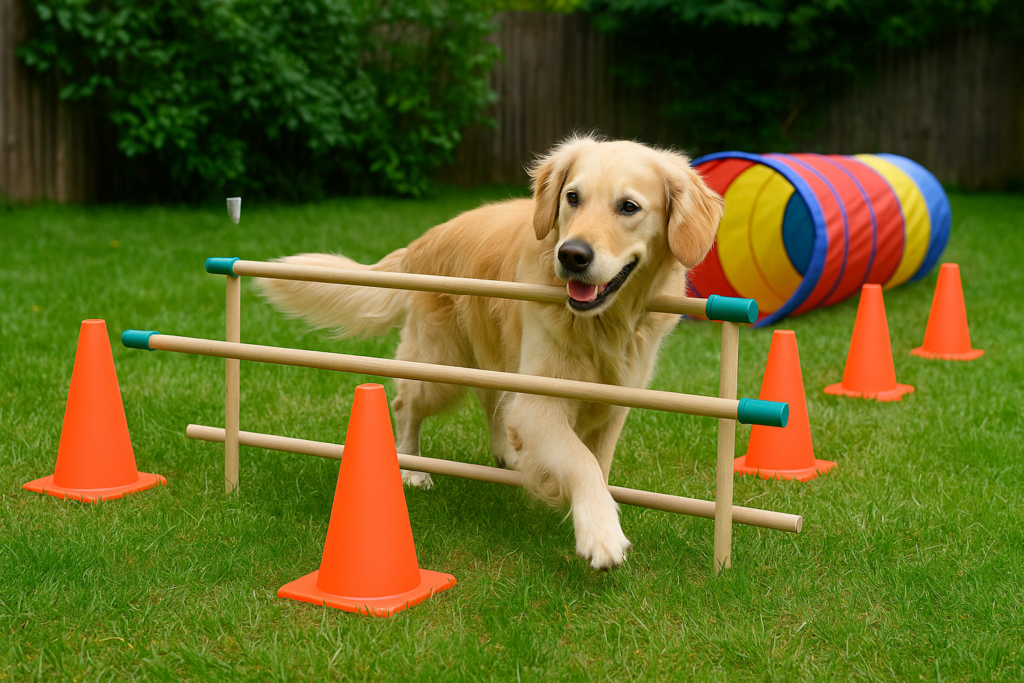
Agility training for dogs is a dynamic sport where dogs navigate obstacle courses guided by their handler’s voice and body cues. Courses typically include jumps, tunnels, weave poles, A-frames, and more. It combines physical exertion with mental challenge—something most dogs naturally crave.
How Agility Works
In agility, dogs run a timed course of 14–20 obstacles in a specific sequence. The handler gives signals, but the dog must perform independently—no leashes, no treats during runs. It’s a real-time test of communication, coordination, and training.
Training begins with basic obstacles one at a time, gradually building up to full sequences. Whether in a class or your backyard, agility training for dogs is always tailored to be safe and fun.
Which Dogs Can Do Agility?

Agility isn’t just for Border Collies. With proper modifications, nearly any healthy dog can enjoy it:
- Large breeds like Golden Retrievers and Dobermans thrive with full courses.
- Small breeds like Papillons and Shelties excel with lower jumps and tight weaves.
- Mixed breeds shine just as brightly—personality and willingness matter more than pedigree.
Senior dogs and puppies need age-appropriate adjustments. Always check with your vet before starting, especially for dogs with joint, heart, or weight issues.
Physical Benefits of Agility Training for Dogs
Agility training for dogs provides one of the most effective full-body workouts in canine fitness. It boosts endurance, coordination, and overall physical health.
Full-Body Fitness
Each course run uses multiple muscle groups. Dogs jump, sprint, weave, and balance—movements that:
- Strengthen limbs and core
- Improve balance and proprioception
- Enhance flexibility through twisting and turning
One client of mine had a young Labrador with boundless energy. After 6 weeks of agility training, his stamina improved, and he became calmer on daily walks.
Weight and Joint Support
Overweight dogs often struggle with mobility. Agility training, when introduced safely, helps:
- Burn excess calories
- Maintain a healthy weight
- Support joint strength through controlled movement
Always avoid high-impact jumps for dogs with arthritis or at-risk breeds like Dachshunds or Bulldogs.
Injury Prevention with Proper Conditioning
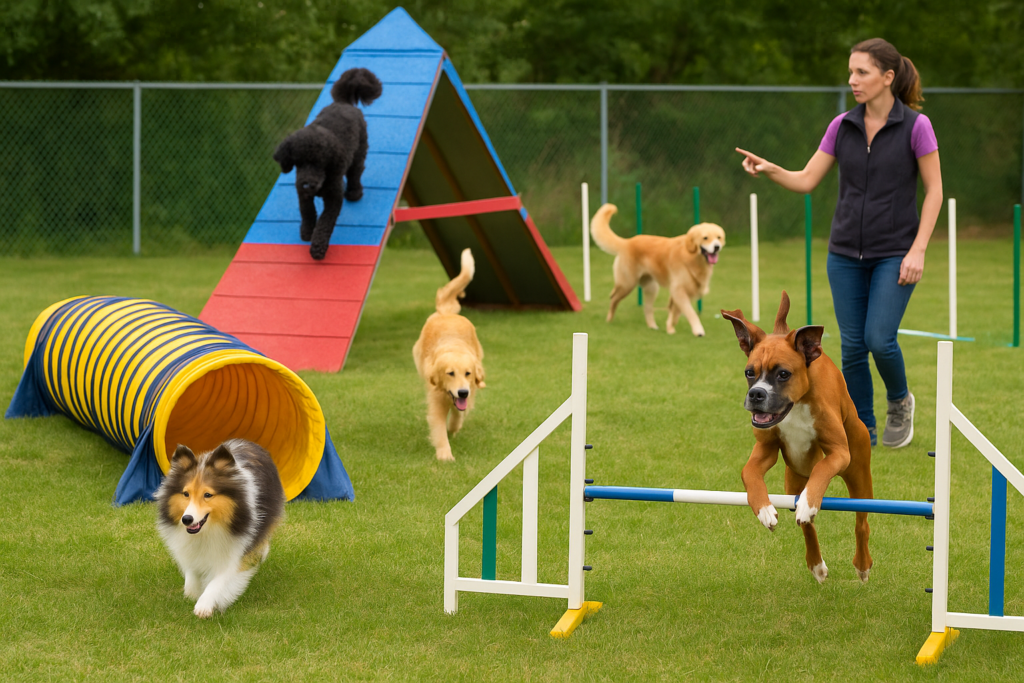
With guidance from your veterinarian or trainer, agility can actually prevent injuries. It improves:
- Coordination, reducing clumsy landings
- Muscle tone, supporting joints and ligaments
- Core strength, which protects the spine
Sample Canadian Costs (Table)
| Service or Gear | Estimated Cost (CAD) |
|---|---|
| Beginner class (6-week series) | $180–$250 |
| Drop-in agility session | $20–$30 |
| Basic tunnel (home use) | $50–$100 |
| Jump set (adjustable) | $70–$150 |
| Private lesson (per hour) | $60–$100 |
These investments can lead to years of better health and shared enjoyment with your dog.
https://www.frontiersin.org/articles/10.3389/fvets.2020.00123/full
Mental Stimulation and Brain Health
Agility training for dogs isn’t just physical—it’s a cognitive workout too. Dogs must learn sequences, interpret cues, and make split-second decisions.
Builds Focus and Decision-Making
Navigating a course requires:
- Recognizing each obstacle
- Responding to handler signals
- Remembering sequences
This keeps dogs alert and mentally engaged. I often recommend agility to clients with working breeds like Border Collies or Belgian Malinois who need daily mental outlets.
Reduces Boredom and Frustration
Bored dogs find their own entertainment—usually chewing furniture or barking at squirrels. Agility keeps them busy in a positive way by:
- Giving them a “job” to do
- Providing new challenges each session
- Satisfying their need for novelty and learning
5-Minute At-Home Agility Checklist
You don’t need a full course to get started. Use this checklist to add mental exercise at home:
✅ Use broomsticks for low jumps
✅ Lay out cones or chairs for weaving
✅ Guide your dog under a table “tunnel”
✅ Practice “pause” on a low stool or mat
✅ Change the layout weekly to keep it fresh
These mini-drills stimulate your dog’s brain and reinforce agility basics between formal classes.
Here’s the revised Behavioral Improvements section with the focus keyword “agility training for dogs” used naturally five times:
Behavioral Improvements
Agility training for dogs can dramatically improve behavior, especially in pets dealing with anxiety, excess energy, or poor impulse control. With routine sessions, dogs gain structure and mental stimulation, leading to calmer behavior at home.
Less Hyperactivity, More Calm
High-energy breeds like Huskies and Terriers often benefit the most from agility training for dogs. This activity provides a positive outlet for energy and reduces:
- Barking or pacing
- Destructive chewing
- Jumping or mouthing
As many veterinarians note, when dogs are mentally and physically fulfilled, hyperactive behaviors often fade.
Also visit: https://doglifeexpert.com/spotting-early-arthritis-in-dogs/
Better Obedience and Manners
Agility builds discipline. Dogs must respond to cues even when excited, reinforcing commands like:
- “Stay” on the pause table
- “Come” when changing directions
- “Sit” or “Wait” between obstacles
Through agility training for dogs, owners often see stronger obedience in everyday life, even during distractions.
Helps Anxious and Reactive Dogs
For shy or reactive dogs, agility training for dogs can be a confidence builder. Gradual exposure to new tasks helps them:
- Trust their handler
- Focus their mind
- Gain emotional stability
I’ve seen rescue dogs blossom through agility training for dogs—transforming from timid and withdrawn to playful and socially engaged.
Social and Relationship Perks
Beyond exercise and discipline, agility training for dogs fosters strong emotional bonds and healthy social habits.
Stronger Bond with Owner
Agility is all about teamwork. You and your dog must communicate through subtle cues, mutual trust, and shared focus. Over time, this improves:
- Your dog’s attention to you
- Your timing and consistency as a handler
- Your overall relationship dynamic
Many owners say they feel “in sync” with their dog for the first time after agility classes.
Positive Socialization with People and Dogs
Agility classes provide a safe, structured setting where dogs encounter:
- Other dogs of different sizes and personalities
- Friendly trainers and new people
- Unfamiliar environments and challenges
This boosts confidence and tolerance, especially in younger dogs still learning social skills.
Builds Confidence in Shy Dogs
The sense of accomplishment from completing obstacles—especially tricky ones like the teeter-totter—can be life-changing for anxious pups. Each small win adds to their sense of control and courage.
One study in Frontiers in Veterinary Science even found agility was linked to reduced fear-based behaviors and improved emotional resilience.
Getting Started Safely
Agility training for dogs can be incredibly rewarding—but only if approached with safety and structure.
Veterinary Clearance and Health Tips
Before starting, consult your vet—especially for:
- Puppies under 18 months
- Senior dogs or those with arthritis
- Dogs recovering from injury
A check-up may include joint evaluation and heart screening. Warm-ups and cool-downs (gentle walking, stretching) help prevent injury.
Foundational Obedience First
Agility builds on basic commands like:
- “Sit”
- “Stay”
- “Come”
- “Watch me”
Practice in low-distraction environments before progressing to courses. This groundwork makes agility easier and safer.
Positive Reinforcement is Key
Training should always be fun. Use:
- High-value treats
- Toys or praise
- Patience and short, frequent sessions
Avoid punishment or forcing your dog over obstacles. Let curiosity lead the way.
Choosing a Trainer or Club
Look for programs that:
- Use certified trainers (e.g., CPDT-KA, Karen Pryor grads)
- Have clean, non-slip surfaces
- Adjust equipment for age, size, and skill
- Offer beginner-friendly classes
Most Canadian clubs offer intro courses between $180–$250.
Adjusting for Age, Size, and Breed (Table)
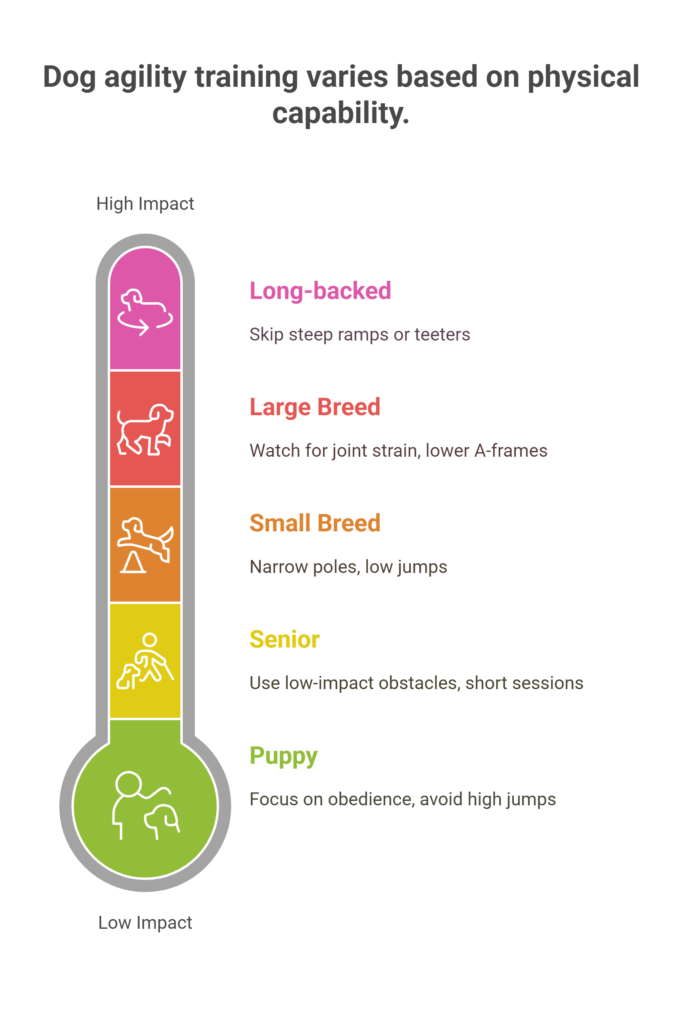
Adapt training to fit your dog—not the other way around.
FAQ: People Also Ask
1. What age can my dog start agility training?
Most dogs can begin foundation agility training around 6 months of age, focusing on flat work and obedience. High-impact obstacles should wait until the dog’s growth plates are closed—typically 15–18 months. Always confirm with your veterinarian before starting.
2. Is agility safe for senior dogs?
Yes, with modifications. Senior dogs benefit from low-impact courses with lower jumps, fewer repetitions, and plenty of rest. Agility training for dogs in their golden years can help maintain mental sharpness and mobility if health allows.
3. Can any breed do agility?
Absolutely. Agility is adaptable to all breeds and mixed breeds. With the right setup, even Bulldogs, Dachshunds, and Great Danes can enjoy a safe and fun course. Success depends more on enthusiasm and handler guidance than breed type.
4. Does agility help with behavior problems?
Yes. Dogs who engage in agility often show improved behavior due to reduced boredom, increased mental stimulation, and clearer communication with their owner. Many owners report fewer destructive behaviors and better obedience after regular training.
5. What gear do I need to start at home?
Basic at-home agility training for dogs can start with:
- A low jump (PVC or broomstick across buckets)
- A tunnel (children’s play tunnels work)
- Cones or poles for weaving
- A platform or mat for pause training
- Treat pouch and clicker (optional)
6. How often should I train my dog in agility?
Start with 2–3 short sessions per week (10–15 minutes). Frequency depends on age, health, and goals. Competitive dogs may train 4–5 times a week, while hobby dogs may just attend weekly classes with at-home practice in between.
Conclusion: Why Agility Is a Lifelong Win for Dogs
Agility training for dogs is more than a hobby—it’s a holistic path to better health, sharper minds, and stronger relationships. Whether your goal is competition or just backyard fun, agility offers a fulfilling experience for both pet and owner.
As a practicing veterinarian, I’ve seen firsthand how agility transforms dogs. One of my clients had an anxious Shepherd mix who, after 10 weeks of weekly agility, became calmer, more obedient, and visibly happier. With the right pace and approach, nearly any dog can benefit from agility—regardless of breed, size, or age.
Before starting, consult your vet, invest in basic obedience, and choose positive, safe training methods. Whether you’re guiding a senior Lab or a young Poodle through their first tunnel, you’ll be building trust, fitness, and joy one obstacle at a time.
Agility training for dogs is one of the most rewarding things you can do together. The benefits are real, lasting, and backed by veterinary science—and the wagging tails say it all.

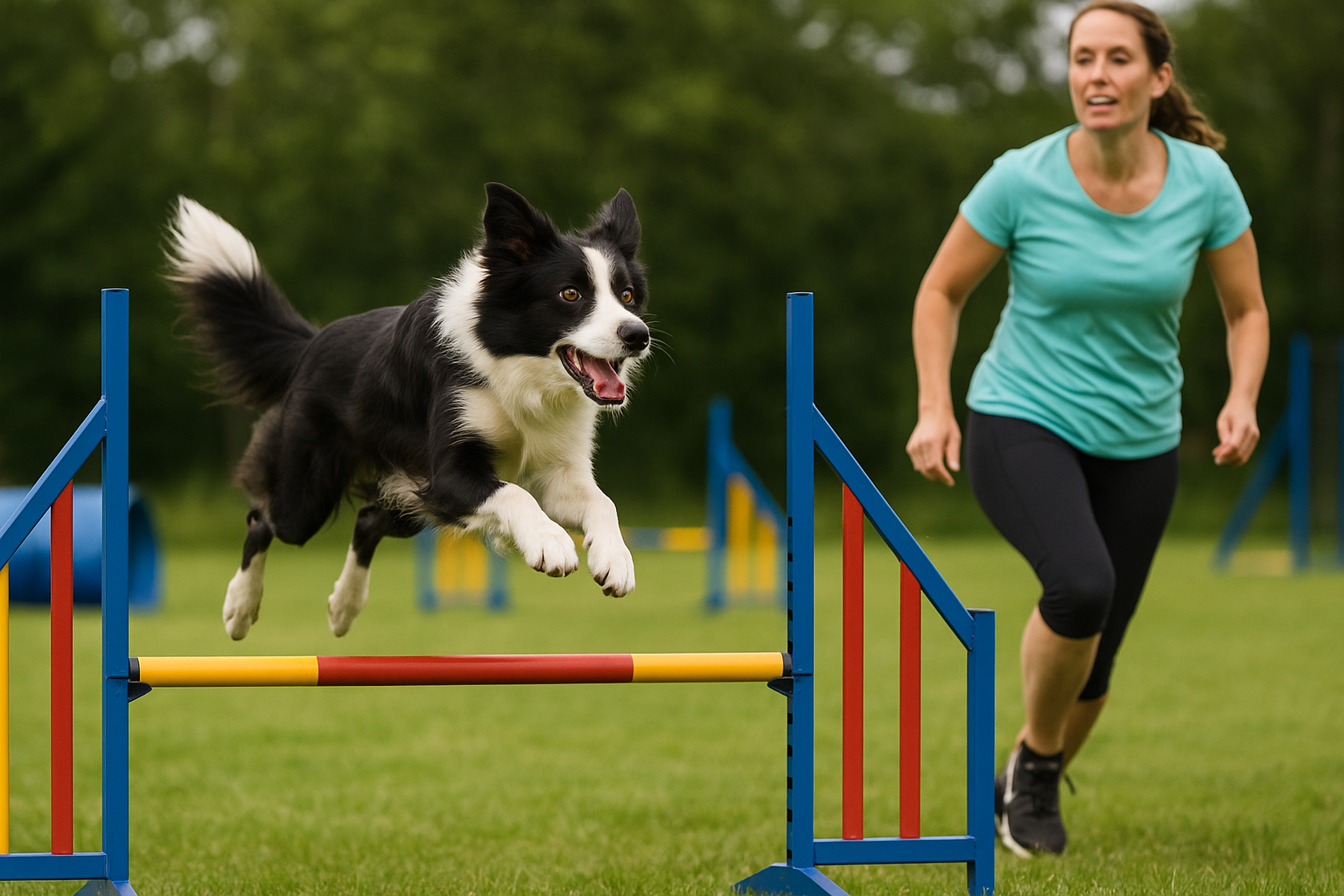


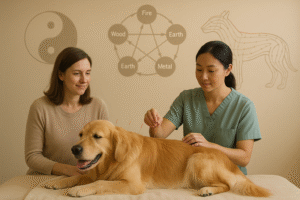
Pingback: Empowered Canine Acupuncture Guide 2025: Key Points, Meridians & Health Benefits
Pingback: 7 Powerful Ways to Treat Dog Allergies and Stop the Itch Fast